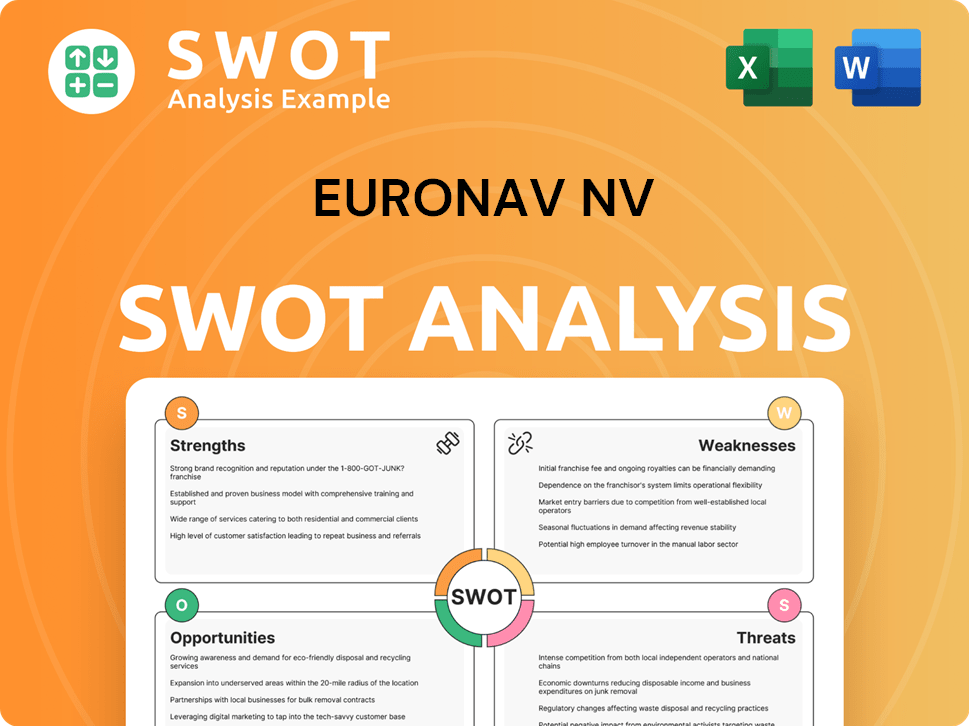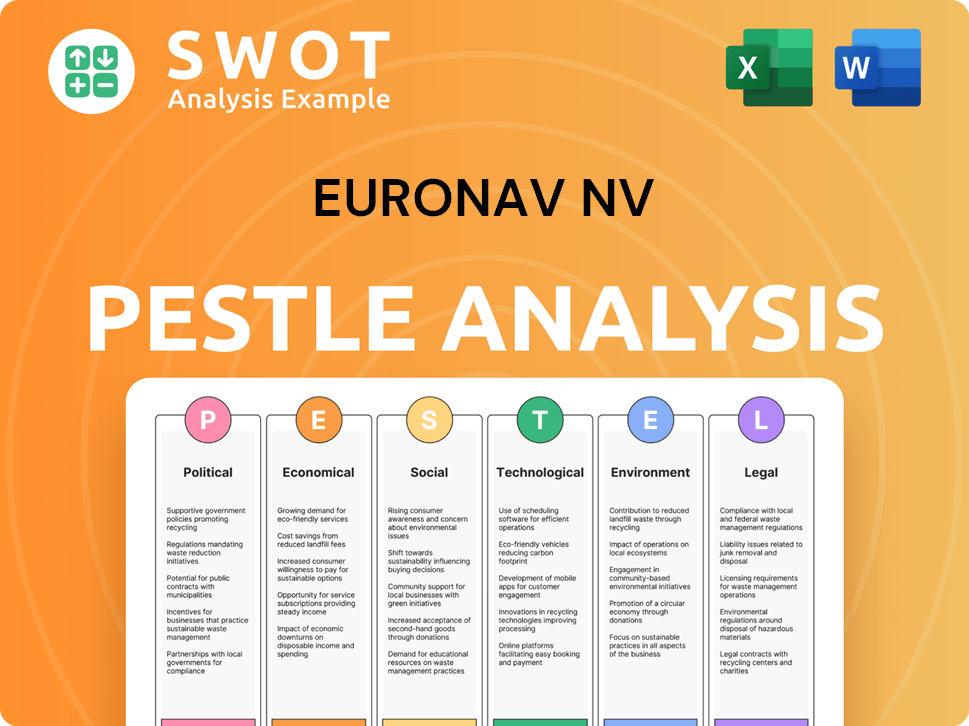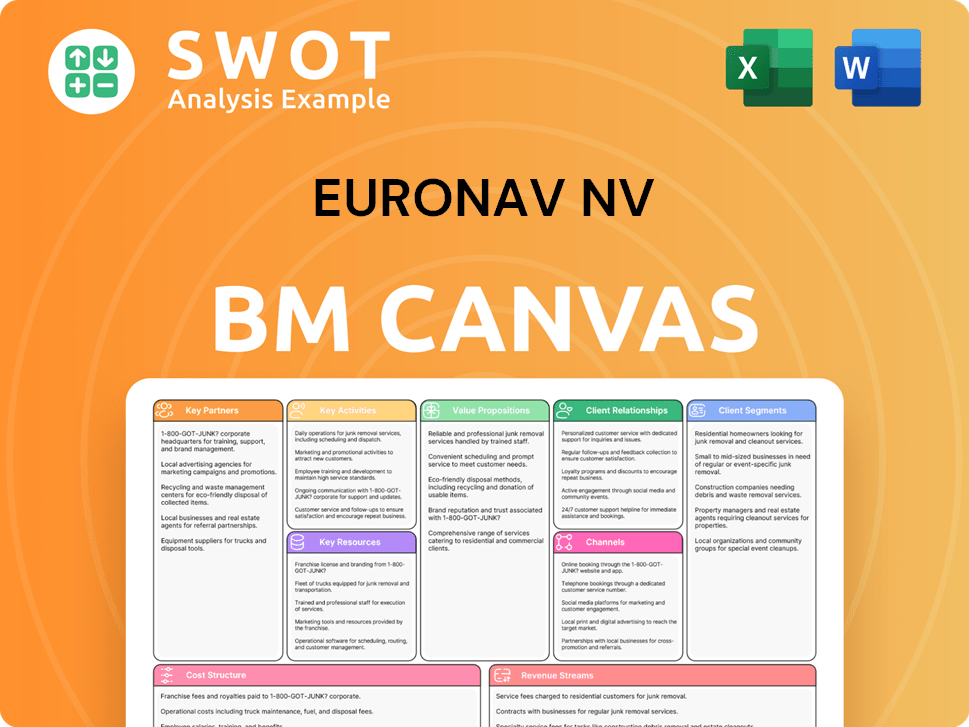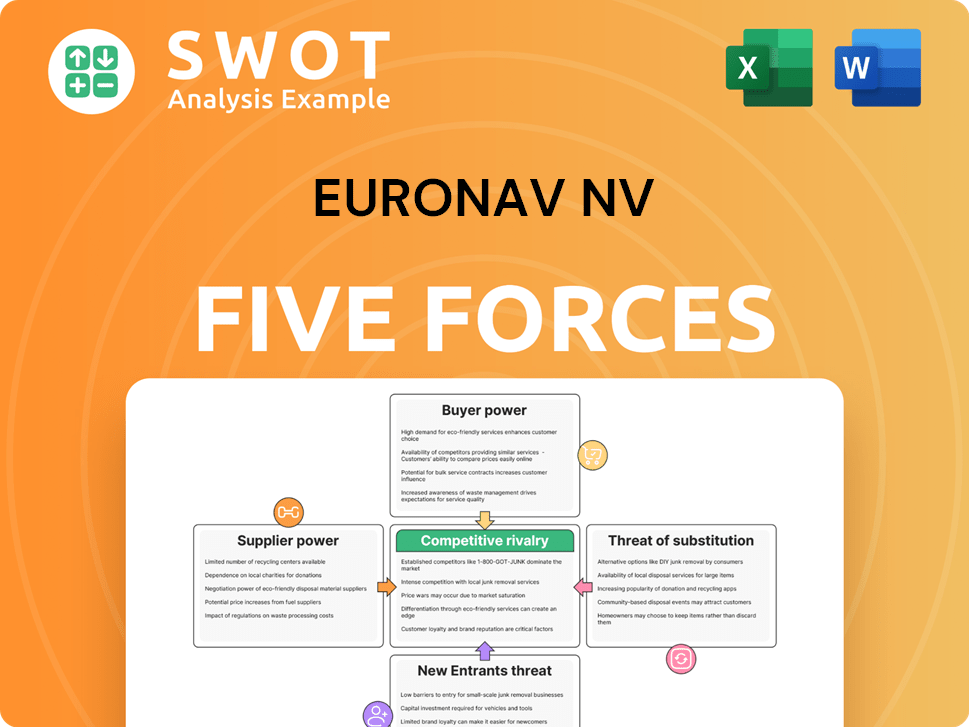Euronav NV Bundle
How Does Euronav NV Navigate the Turbulent Waters of the Oil Tanker Market?
The global oil tanker market is a high-stakes arena, constantly reshaped by geopolitical events, fluctuating energy demands, and the push for greener practices. As a major player in this sector, understanding Euronav NV SWOT Analysis is crucial for anyone looking to navigate the complexities of maritime transport and the oil tanker market. This analysis dives deep into Euronav's position within this competitive landscape.

This exploration of the Euronav NV competitive landscape will dissect its key rivals, analyze its market share, and evaluate its strategic positioning within the tanker shipping industry. We'll examine Euronav's financial performance, fleet composition, and responses to industry regulations, providing a comprehensive market analysis. Ultimately, this examination aims to provide actionable insights into how Euronav competes, adapting to the ever-changing dynamics of the crude oil market.
Where Does Euronav NV’ Stand in the Current Market?
Euronav NV holds a significant position in the tanker shipping industry, particularly within the crude oil transportation sector. Its core operations center around the ownership and operation of a fleet of Very Large Crude Carriers (VLCCs) and Suezmax tankers. These vessels are essential for transporting crude oil over long distances, serving major oil companies, refiners, and commodity traders globally. The company's value proposition lies in providing efficient, reliable, and safe transportation services, crucial for the global oil supply chain.
The company's strategic focus remains primarily on crude oil transportation and storage. While the company has been involved in Floating Production Storage and Offloading (FPSO) vessels, it has not significantly diversified into other shipping segments. This strategic concentration allows Euronav to leverage its expertise in crude oil handling and storage, maintaining a strong position in the market. The global nature of crude oil trade routes ensures Euronav's geographic presence is inherently international, with its vessels operating across major shipping lanes.
In 2023, Euronav reported a net profit of $468.9 million, demonstrating robust financial health. The company's financial strength is further highlighted by a net income of $129.5 million in Q1 2024. This financial performance supports fleet maintenance, potential expansions, and resilience against market fluctuations. Understanding the Growth Strategy of Euronav NV provides additional insights into the company's market approach.
Euronav's market analysis reveals a strong position in the VLCC and Suezmax segments. The company's focus on these large vessel types positions it to capitalize on long-haul crude oil transportation demands. Euronav's competitive advantages include its fleet size, operational expertise, and established relationships with key industry players.
Key competitors in the tanker shipping industry include Frontline, Tankers International, and Teekay Tankers. These companies also operate large fleets of crude oil tankers, competing for market share and contracts. The competitive landscape is influenced by fleet size, operational efficiency, and financial stability.
The Euronav NV competitive landscape is shaped by factors such as vessel supply, demand for crude oil transportation, and geopolitical events. The company's ability to navigate these challenges and maintain a competitive edge is crucial. Strategic partnerships and alliances can also impact Euronav's market position.
While specific market share figures fluctuate, Euronav consistently ranks as one of the largest independent owners and operators of VLCCs and Suezmax tankers. This leadership position is a key indicator of its market strength. Market share analysis involves assessing fleet capacity, utilization rates, and revenue generation compared to competitors.
Euronav's competitive advantages include a large, modern fleet, strong financial performance, and established customer relationships. Disadvantages can include exposure to volatile freight rates, geopolitical risks, and the cyclical nature of the tanker market. Understanding these factors is vital for strategic planning.
- Fleet Size and Composition: Euronav's large fleet of VLCCs and Suezmax tankers provides economies of scale and flexibility in meeting customer demands.
- Financial Health: The company's strong financial performance, with a net profit of $468.9 million in 2023, allows for investments in fleet upgrades and expansion.
- Market Volatility: The tanker shipping industry is subject to fluctuations in freight rates, influenced by global oil supply and demand, and geopolitical events.
- Geopolitical Risks: Trade routes and vessel operations can be affected by political instability, sanctions, and regional conflicts.
Euronav NV SWOT Analysis
- Complete SWOT Breakdown
- Fully Customizable
- Editable in Excel & Word
- Professional Formatting
- Investor-Ready Format

Who Are the Main Competitors Challenging Euronav NV?
Understanding the Euronav NV competitive landscape involves a deep dive into the tanker shipping industry. This sector is characterized by intense competition, influenced by factors such as fluctuating charter rates, operational efficiency, and global demand for crude oil transportation. The company's market position is constantly reshaped by the actions of its rivals and broader industry trends.
Euronav market analysis reveals a complex environment where strategic decisions and adaptability are crucial for sustained success. The company faces both direct and indirect competition, each posing unique challenges. The dynamic nature of the oil tanker market necessitates continuous monitoring and strategic adjustments to maintain a competitive edge.
Euronav NV competitors include a range of companies vying for market share. These competitors employ various strategies to gain an advantage, from aggressive pricing to technological innovation. The competitive landscape is also influenced by mergers, alliances, and the evolving energy landscape.
The primary direct competitors of Euronav are other major independent tanker owners and operators. These companies, much like Euronav, own and operate large fleets of crude oil tankers, particularly Very Large Crude Carriers (VLCCs) and Suezmax vessels. They compete directly on routes, charter rates, and operational efficiency.
Key competitors include Frontline Ltd., DHT Holdings, Inc., and Teekay Tankers Ltd. These companies have significant fleets and compete with Euronav across various segments of the crude oil transportation market. Their strategies and performance directly impact Euronav's market position.
Frontline is a major player in the tanker industry, often competing directly with Euronav. They compete on vessel availability, pricing, and operational efficiency across various routes and chartering opportunities. The companies often vie for the same contracts and clients.
DHT Holdings primarily focuses on VLCCs, making it a direct competitor, especially in the spot market for large crude carriers. They compete with Euronav for similar contracts and routes, with their performance directly influencing the market dynamics.
Teekay Tankers has a more diversified fleet, including Aframax and LR2 vessels, but still competes directly in the Suezmax segment. This competition impacts Euronav's ability to secure contracts and maintain market share in the Suezmax sector.
These competitors challenge Euronav through various means, including price competition, innovation in fleet management, branding, and distribution. Each strategy aims to capture a larger share of the market and improve profitability.
Besides direct rivals, Euronav faces indirect competition from integrated oil companies and the broader energy transition. The increasing focus on renewable energy sources and potential mergers and alliances within the industry further shape the competitive environment. For example, the fluctuations in charter rates, which are highly sensitive to supply and demand, directly affect the profitability of tanker companies. In 2024, VLCC rates saw significant volatility, with spot rates varying widely based on geopolitical events and seasonal demand. Furthermore, the rise of environmental regulations and the push for sustainable shipping practices add another layer of complexity to the Euronav NV competitive landscape. For more insights, read about the Growth Strategy of Euronav NV.
Several factors influence the competitive dynamics within the tanker shipping industry. These factors determine the success and profitability of each company. Understanding these elements is crucial for analyzing the Euronav NV market analysis.
- Price Competition: Charter rates are highly sensitive to supply and demand, making price a critical factor.
- Operational Efficiency: Optimizing fuel consumption and operational practices is essential for cost management.
- Branding and Reputation: Reliability and safety are vital for attracting clients and securing contracts.
- Distribution Networks: Strong relationships with brokers and charterers are crucial for vessel bookings.
- Fleet Composition: The size, age, and type of vessels in a fleet impact competitiveness.
- Geopolitical Factors: Political stability and trade routes significantly influence the industry.
- Regulatory Compliance: Adherence to environmental and safety regulations is essential.
Euronav NV PESTLE Analysis
- Covers All 6 PESTLE Categories
- No Research Needed – Save Hours of Work
- Built by Experts, Trusted by Consultants
- Instant Download, Ready to Use
- 100% Editable, Fully Customizable

What Gives Euronav NV a Competitive Edge Over Its Rivals?
The competitive landscape for Euronav NV is shaped by its strategic focus and operational strengths within the tanker shipping industry. Key milestones include its expansion of fleet size and its commitment to modernizing its vessels, particularly in the VLCC (Very Large Crude Carrier) and Suezmax segments. These moves have enhanced its ability to capitalize on market opportunities and maintain a leading position in the oil tanker market.
Euronav's competitive edge is rooted in its substantial fleet, which allows for economies of scale and operational efficiencies. This scale, combined with a focus on a modern and fuel-efficient fleet, enables the company to meet stringent environmental regulations and enhance relationships with major oil companies and traders. The company's strategic diversification into FPSO (Floating Production Storage and Offloading) vessels further strengthens its market position.
The Marketing Strategy of Euronav NV emphasizes its reliability, safety record, and environmental commitment, which are critical in securing long-term contracts and maintaining customer loyalty. As of early 2024, the tanker shipping industry continues to be influenced by factors such as geopolitical events, fluctuating oil prices, and evolving environmental regulations, all of which impact Euronav's strategic decisions and competitive advantages.
Euronav's large fleet size, especially in VLCC and Suezmax vessels, provides significant operational advantages. This scale allows the company to optimize routes and secure favorable terms. As of 2024, Euronav's fleet capacity remains a key differentiator in the competitive landscape.
The modernity of Euronav's fleet is a significant advantage, with newer vessels being more fuel-efficient and compliant with environmental regulations. This focus on fleet renewal helps reduce operating costs and appeals to environmentally conscious charterers. The company's investment in newer vessels is ongoing.
Strong relationships with major oil companies, refiners, and traders provide Euronav with a stable base of business and repeat contracts. These long-term partnerships are crucial for maintaining market share and ensuring consistent revenue streams in the tanker shipping industry. Customer loyalty is a key asset.
Euronav's involvement in FPSO vessels demonstrates strategic diversification, leveraging its expertise in crude oil handling and storage. This diversification offers a unique service that not all competitors possess, enhancing its market position. This diversification strategy provides additional revenue streams.
Euronav's competitive advantages are substantial, built on its large fleet, modern vessels, and strong customer relationships. These factors contribute to its ability to navigate the volatile tanker shipping market effectively.
- Fleet Size: Provides economies of scale and operational flexibility.
- Modern Fleet: Ensures fuel efficiency and compliance with environmental standards.
- Customer Relationships: Fosters loyalty and secures long-term contracts.
- Strategic Diversification: Enhances market position through FPSO involvement.
Euronav NV Business Model Canvas
- Complete 9-Block Business Model Canvas
- Effortlessly Communicate Your Business Strategy
- Investor-Ready BMC Format
- 100% Editable and Customizable
- Clear and Structured Layout

What Industry Trends Are Reshaping Euronav NV’s Competitive Landscape?
The tanker shipping industry, and consequently the Euronav NV competitive landscape, is currently undergoing significant shifts driven by technological advancements, stringent environmental regulations, and global economic realignments. These factors are reshaping the operational dynamics and strategic priorities within the maritime transport sector. Understanding these trends is crucial for assessing Euronav's market analysis and future prospects.
The primary risks and future outlook for Euronav hinge on its ability to adapt to these industry-wide transformations. The company's financial performance compared to competitors will depend on how effectively it navigates challenges such as decarbonization mandates and fluctuating oil demand. Strategic decisions regarding fleet modernization, partnerships, and operational efficiencies will be pivotal in determining its long-term competitive position.
The tanker shipping industry is witnessing a surge in technological advancements, including fuel-efficient vessel designs and digital navigation systems. Regulatory pressures, particularly from the International Maritime Organization (IMO), are pushing for reduced emissions. Global economic shifts, including changes in oil demand and geopolitical tensions, are influencing charter rates and fleet utilization.
Euronav faces challenges such as the substantial capital expenditure required for fleet upgrades to meet environmental regulations. Declining long-term crude oil demand due to the energy transition poses a threat. Increased competition from new market entrants with modern fleets intensifies pricing pressures. The company must also manage higher operating costs due to stricter regulations.
Euronav can capitalize on the push for decarbonization by adopting sustainable shipping practices, potentially gaining a competitive edge. Growth opportunities exist in emerging markets, particularly in Asia, which continue to drive crude oil demand. Product innovations, like advanced vessel designs, could provide new revenue streams. Strategic partnerships can help navigate the complexities of decarbonization.
Euronav is actively modernizing its fleet and exploring alternative fuel options to remain competitive. The company focuses on long-term contracts and strategic partnerships to secure stable revenues. These measures aim to address industry challenges and capitalize on emerging opportunities. The ability to adapt will be crucial for long-term success.
Euronav's market share analysis indicates a strong position in the Very Large Crude Carrier (VLCC) market. The company's success hinges on its ability to navigate regulatory changes, technological advancements, and shifts in global oil demand. Understanding the competitive landscape is essential for making informed investment decisions. For a deeper dive into the company's financial model, consider reading about the Revenue Streams & Business Model of Euronav NV.
- Fleet Modernization: Investing in newer, more fuel-efficient vessels and retrofitting existing ships to meet environmental standards.
- Alternative Fuels: Exploring and adopting alternative fuels like LNG or ammonia to reduce emissions.
- Strategic Partnerships: Forming alliances with technology providers and alternative fuel suppliers to enhance capabilities.
- Market Expansion: Identifying and capitalizing on growth opportunities in emerging markets, especially in Asia.
Euronav NV Porter's Five Forces Analysis
- Covers All 5 Competitive Forces in Detail
- Structured for Consultants, Students, and Founders
- 100% Editable in Microsoft Word & Excel
- Instant Digital Download – Use Immediately
- Compatible with Mac & PC – Fully Unlocked

Related Blogs
- What are Mission Vision & Core Values of Euronav NV Company?
- What is Growth Strategy and Future Prospects of Euronav NV Company?
- How Does Euronav NV Company Work?
- What is Sales and Marketing Strategy of Euronav NV Company?
- What is Brief History of Euronav NV Company?
- Who Owns Euronav NV Company?
- What is Customer Demographics and Target Market of Euronav NV Company?
Disclaimer
All information, articles, and product details provided on this website are for general informational and educational purposes only. We do not claim any ownership over, nor do we intend to infringe upon, any trademarks, copyrights, logos, brand names, or other intellectual property mentioned or depicted on this site. Such intellectual property remains the property of its respective owners, and any references here are made solely for identification or informational purposes, without implying any affiliation, endorsement, or partnership.
We make no representations or warranties, express or implied, regarding the accuracy, completeness, or suitability of any content or products presented. Nothing on this website should be construed as legal, tax, investment, financial, medical, or other professional advice. In addition, no part of this site—including articles or product references—constitutes a solicitation, recommendation, endorsement, advertisement, or offer to buy or sell any securities, franchises, or other financial instruments, particularly in jurisdictions where such activity would be unlawful.
All content is of a general nature and may not address the specific circumstances of any individual or entity. It is not a substitute for professional advice or services. Any actions you take based on the information provided here are strictly at your own risk. You accept full responsibility for any decisions or outcomes arising from your use of this website and agree to release us from any liability in connection with your use of, or reliance upon, the content or products found herein.